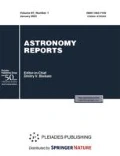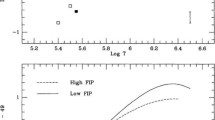Abstract
Evidence that the distribution of the abundances of admixtures with low first-ionization potentials (FIP < 10 eV) in the lower solar corona could be associated with the typology of the largescale magnetic field is presented. Solar observations show an enhancement in the abundances of elements with low FIPs compared to elements with high FIPs (>10 eV) in active regions and closed magnetic configurations in the lower corona. Observations with the ULYSSES spacecraft and at the Stanford Solar Observatory have revealed strong correlations between the manifestation of the FIP effect in the solar wind, the strength of the open magnetic flux (without regard to sign), and the ratio of the large-scale toroidal and poloidal magnetic fields at the solar surface. Analyses of observations of the Sun as a star show that the enhancement of the abundances of admixtures with low FIPs in the corona compared to their abundances in the photosphere (the FIP effect) is closely related to the solar-activity cycle and also with variations in the topology of the large-scale magnetic field. A possible mechanism for the relationship between the FIP effect and the spectral type of a star is discussed in the framework of solar–stellar analogies.
Similar content being viewed by others
References
J.-F. Donati and J. D. Landstreet, Ann. Rev. Astron. Astrophys. 47, 333 (2009).
A.A. Vidotto, S. G. Gregory, M. Jardine, J. F. Donati, et al., Mon. Not. R. Astron. Soc. 441, 2361 (2014).
V. See, M. Jardine, A. A. Vidotto, J.-F. Donati, et al., Mon. Not. R. Astron. Soc. 462, 4442 (2016).
R.W. Noyes, N.O. Weiss, and A. H. Vaughan, Astrophys. J. 287, 769 (1984).
J.-F. Donati, M. M. Jardine, P. Petit, J. Morin, et al., Astron. Soc. Pacif. Conf. Ser. 384, 156 (2008).
L. Fletcher, P. J. Cargill, S. K. Antiochos, and B. V. Gudiksen, Space Sci. Rev. 188, 211 (2015).
S. R. Pottasch, Mon. Not. R. Astron. Soc. 125, 543 (1963).
J. M. Laming, Living Rev. Solar Phys. 12, 2 (2015).
K. G. Widing and U. Feldman, Astrophys. J. 555, 426 (2001).
V. Tomozov, Soln.-Zemn. Fiz. 23, 23 (2013).
K. H. Schatten, J. M. Wilcox, and N. F. Ness, Solar Phys. 6, 442 (1969).
B. E. Wood, J. M. Laming, and M. Karovska, Astrophys. J. 753, 76 (2012).
D. Brooks, D. Baker, L. van Driel-Gesztelyi, and H. Warren, Nat. Commun. 8, 183 (2017).
A. Buergi and J. Geiss, Solar Phys. 103, 347 (1986).
J. Geiss, G. Gloeckler, and R. von Steiger, Space Sci. Rev. 72, 49 (1995).
R. von Steiger, J. Geiss, G. Gloeckler, and A. B. Galvin, Space Sci. Rev. 72, 71 (1995).
T. L. Duvall, Jr., P. H. Scherrer, L. Svalgaard, and J. M. Wilcox, Solar Phys. 61, 233 (1979).
J. T. Hoeksema, Space Sci. Rev. 72, 137 (1995).
E. S. Vernova, M. I. Tyasto, and D. G. Baranov, Solar Phys. 289, 2845 (2014).
J. M. Laming, J. J. Drake, and K. G. Widing, Astrophys. J. 443, 416 (1995).
N. A. Schwadron, L. A. Fisk, and T. H. Zurbuchen, Astrophys. J. 521, 859 (1999).
J.M. Laming, Astrophys. J. 614, 1063 (2004).
M. J. Aschwanden, Physics of the Solar Corona. An Introduction with Problems and Solutions, 2nd ed. (Springer, Berlin, Heidelberg, 2005).
S. V. Shestov, V. M. Nakariakov, A. S. Ulyanov, A. A. Reva, and S. V. Kuzin, Astrophys. J. 840, 64 (2017).
Author information
Authors and Affiliations
Corresponding author
Additional information
Original Russian Text © V.V. Pipin, V.M. Tomozov, 2018, published in Astronomicheskii Zhurnal, 2018, Vol. 95, No. 4, pp. 299–306.
Rights and permissions
About this article
Cite this article
Pipin, V.V., Tomozov, V.M. The Nature of Variations in Anomalies of the Chemical Composition of the Solar Corona with the 11-Year Cycle. Astron. Rep. 62, 281–287 (2018). https://doi.org/10.1134/S1063772918040054
Received:
Accepted:
Published:
Issue Date:
DOI: https://doi.org/10.1134/S1063772918040054




